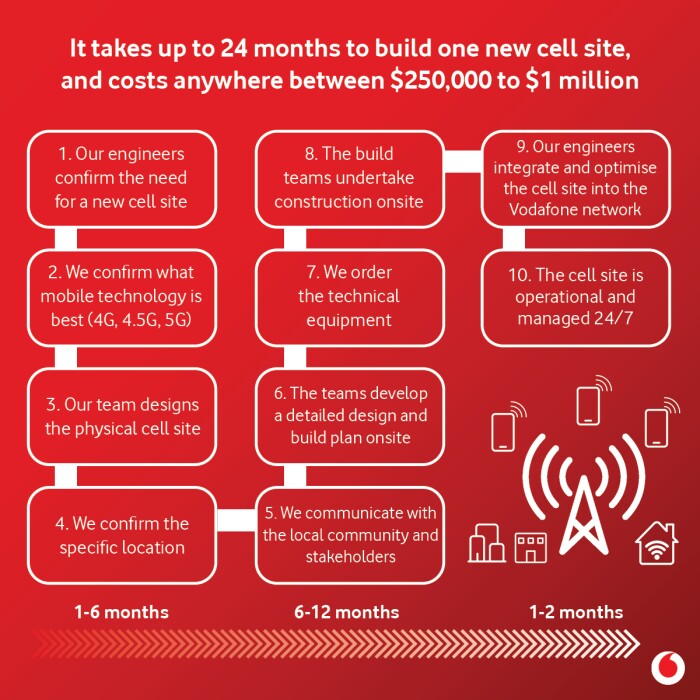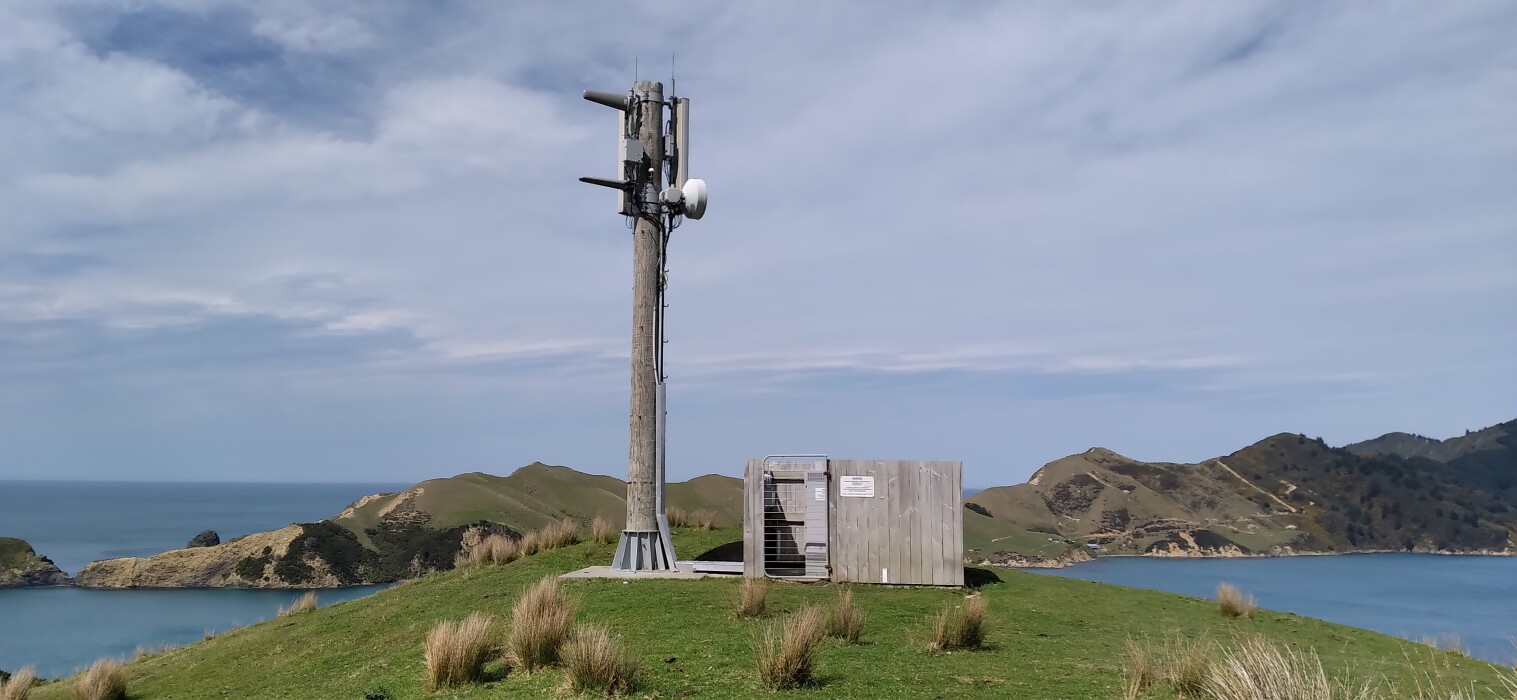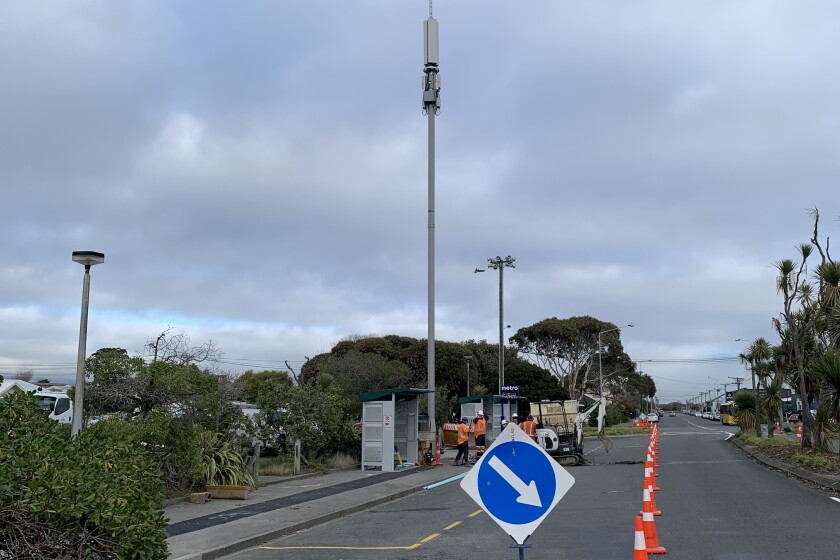With data use increasing by more than 40% every year, and more people relying on mobile networks to stay connected, we need to continually invest in building new cell sites - sometimes also called ‘cell towers’ or ‘mobile phone towers’.
Customers often request new cell sites, or increased mobile coverage in areas - be it for mobile phone connections or for wireless broadband internet access. But most people are unaware of the time, effort and cost that goes into building this critical digital infrastructure.
One single cell site can take anywhere between 6-18 months on average to build - or even up to 24 months - and cost somewhere between $250,000 to $1 million!
We have multiple engineers, site acquisition managers, resource consent planners and construction teams working to scope out, design, build and test mobile coverage to ensure that we build cell sites in the areas that offer maximum coverage as well as maximum safety for all those involved.
We can break the key stages into 10 main steps, and here’s a brief look at what’s involved.
1. Confirming the strategy - why we need a new cell site
Often we build a new cell site because there is no coverage in the area - and the Rural Connectivity Group (RCG) sites are a great example of this. But it can also be due to increasing urbanisation, or because of a mobile black spot on a popular section of road on the urban fringe.
Each cell site has a capacity limit, in that it can process a finite amount of data at any one time. And with more and more smartphones, connected devices and data-heavy applications like video streaming, we need to continue to grow capacity.
Just like you can only have a certain number of people on a plane, a cell site has an upper limit. So this means building extra cell sites in popular areas to supplement other towers.
2. Determining what mobile technology is most appropriate
What the cell site will be used for is very important - whether we need long-range coverage such as via rural wireless broadband and the RBI initiatives with low spectrum 4G radio waves travelling up to 35kms. Or if it’s an urban area where we need higher density, shorter-range coverage by using higher frequency 4.5G or 5G technology. Here is more information on how we deliver the internet in Aotearoa.

There are both macro and micro sites - either large cell towers or small in-building solutions. Sometimes, due to heavy construction materials, mobile phone radio waves have trouble penetrating the centre of concrete buildings. Or, if there will be lots of people in the same area, we need to increase the capacity with a dedicated, nearby cell site.
Malls and convention centres are great examples where we need to build small cells within the building, to ensure our customers can continue to connect to the internet even when deep inside. This however can be very expensive for building owners, so often we team up with other industry players on sensible infrastructure sharing so that this is affordable while offering customers a great experience. As people rely more on their devices, and work is increasingly completed ‘on the go’, we need to build more of these small cells.
3. Designing the physical cell site
We have a full expert team of designers who take a wide range of factors into account when designing a site. For the rural sites, they often need to be very high (i.e. 20-30 metres) to cover a greater range - while in an urban situation the tower may only need to be 15-20 metres high.
The orientation of the antenna is also important - where to point the tower to capture the most traffic and cater to the expected demand from devices in the area.
We also take into account safety aspects such as electromagnetic frequencies (EMF) to ensure that radio waves and radiation is always going to be kept at safe limits.
4. Confirming the specific location
Selecting a cell site location involves balancing a variety of inputs and criteria. These include technical radio design requirements (choosing a site that provides sufficient coverage), the availability of a suitable property (a willing landowner), and resource consent requirements. During this process Vodafone also takes into account community concerns and seeks locations and site designs that minimise adverse visual effects on the surrounding environment.
Additional considerations in the site selection process include ensuring the site can be safely accessed, constructed and serviced, and is cost effective to build and operate. In addition, a site needs to be able to connect into a wider telecommunications network. This is called “backhaul” and can be achieved via a mixture of a wireless network via a dish antenna and fixed line network via a fibre optic cable.
Often there might be only be one possible location to build a cell site in an area, once all of the necessary factors have been taken into account.
5. Communicating with the local community
Sometimes we may need to go through a Resource Management Act (RMA) consenting process, which can include engaging with the local council, iwi, Department of Conservation (DOC) or community groups depending on where the site is. There is also the Telecommunications Forum (TCF) guidelines for undertaking community engagement for wireless telecommunications facilities, which we strictly follow whenever needed.
Most of the time people are very pleased that we are building a cell site and increasing the local digital infrastructure, but sometimes people are concerned about safety elements so we try to reassure them that mobile cell towers are safe - and we often refer locals to the Ministry of Health or World Health Organisation in case they want more detail.
6. Getting started onsite
Before we start building, we begin with a ‘caravan’, when all the sub-contractors involved in building, designing and operating the cell site come together and the entire site is walked through from end to end. This includes Vodafone NZ team members, but also representatives from Downer and other third parties we work with. Ensuring we’re all on the same page is incredibly important.
Thereafter a detailed design plan gets developed, with CAD drawings of the infrastructure created.
7. Ordering the technical equipment
Once we have an approved site location (in terms of an agreement with a willing landowner and a resource consent, if required), we can get onto ordering the equipment. There is always a massive list of materials to order such as the radio access equipment (from our long-term technology partner Nokia), other telecommunication equipment and site construction materials from various other suppliers both locally and overseas.
Equipment availability and freight may hold up the physical build so we order equipment ahead and coordinate the logistics to ensure a seamless site build project.
8. Undertaking the physical site build
Finally, all of the activities converge - once the site has the right to build, all the equipment has been delivered, and the consents received, we get onto actually building the site. A lot of coordination is required at this point - the civil work (spade in the ground), mast rigging and steel work, electrical elements for power, and getting riggers onsite to install the antennas.
Generally, it requires lots of coordination from our build partner, Downer, to ensure this all runs as smoothly as possible.
Sometimes it can take a long time to get to this point, such as with the RBI1 initiative where on average it took 21 months to acquire one site and just 2 months to complete the build. But each site is different, so depending on local conditions it can be complicated and time consuming.
9. Integrating the cell site into the Vodafone network
Once the site is built, we need to ‘drive test’ it to ensure it’s preforming as expected, in accordance with the design. This means we need to test the connection to ensure that phones work and internet access is strong. Often we need to optimise the network - such as adjust the antenna orientation especially if the site is near water - to optimise the coverage and get the best performance possible.
We measure EMF and safety considerations, to check that the site is operating within a fraction of the non-ionising radiation limits.
We also need to ensure this new site integrates with other cell sites in the Vodafone network, so that there is a streamlined transfer of connection if someone is moving around and so the call doesn’t drop out, for example.
10. Cataloguing the cell site records & monitoring it 24/7
Once the site goes live, the final step is to catalogue all of the “as built documents” to ensure we can perform quality checks at any point in the future. As this will be infrastructure that will be there for 20-30 years, we compile a massive dossier of photos, certificates and site drawings to keep these on file for future needs!
We also continue to monitor the site 24/7, as part of our Network Operations Centre. We try to ensure continuity of service even when a single cell site has an outage, caused by things like a power cut or wild weather and update our customers via our Network Status page.
All up, it’s a massive process and one that takes numerous people to ensure we get the best outcome. When costs total to up to $1 million, or the timeline pushes out to 18-24 months, there can be a lot involved in ensuring each and every cell site gets built to the right specs and will meet the ever-growing customer demand for data.
We’re committed to continuing to invest in our digital infrastructure and network, and our aim is for our customers to stay connected and experience seamless connectivity wherever they work, live and play.




